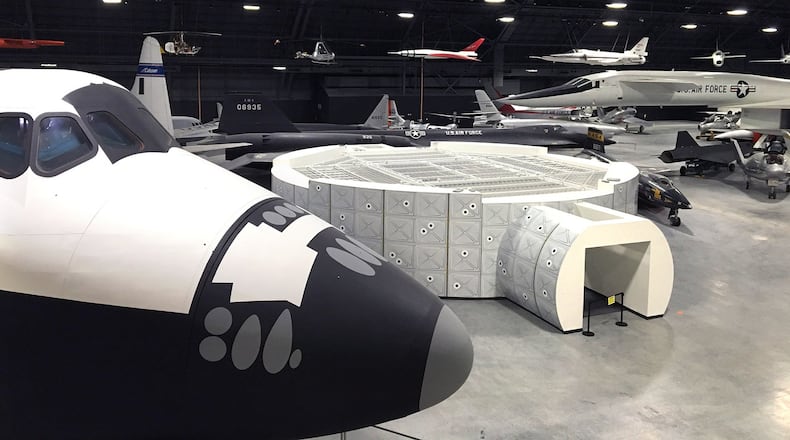5 amazing things to see at the @AFmuseum new hangar. https://t.co/kcBAKHIZZs pic.twitter.com/mQiIUGgSpg
— Dayton Daily News (@daytondailynews) January 12, 2017
While the number of visitors was on the upswing, the total number fell 1.1 percent from 2015 –and last year was the lowest attended since 1994 when 808,152 people visited, museum figures indicated.
Museum Director John “Jack” Hudson anticipates a climb in attendance in 2017.
“For that seven month period (in 2016), we did great,” he said. “To get that kind of upswing from the numbers is just terrific and it says a lot to what people were looking forward to.”
With visitors drawn to three science-related “learning nodes,” or classrooms in the new addition, and teaching activities at the museum, educational outreach numbers reached a record of around 200,000 visitors, the retired Air Force three-star general said.
The totals include an actual count of visitors through a security checkpoint in the main lobby and estimates of crowd attendance at outdoor events at the museum campus, officials said.
Credit: DaytonDailyNews
Waiting for the big day
Attendance in the first half of 2016 may have been down because patrons were waiting for the opening of the new building, and the former home of the Presidential and Research and Development galleries in a restricted-access hangar on Wright-Patterson were closed for months to move a parade of exotic and unique planes into the new building.
The 224,000-square-foot hangar houses four galleries: Presidential, Research and Development, Global Reach and Space.
Inside is the largest collection of U.S. presidential aircraft, including SAM 26000, which served eight presidents from John F. Kennedy to Bill Clinton, and one-of-a-kind research aircraft like the X-15 rocket plane and the delta-winged, six-engine powered XB-70 Valkyrie experimental bomber. The hangar also has a Titan IV, a towering rocket on its side, and the C-141 Starlifter “Hanoi Taxi” that brought home the first U.S POWs from the Vietnam War.
Estimates show the museum has a $40 million economic impact each year.
A $250,000 advertising push paid for by outside organizations tapped into major regional markets to try to attract more visitors when the expansion opened, said Tony Sculimbrene, executive director of the National Aviation Heritage Alliance in Dayton.
“Opening the fourth (museum gallery) building has had the impact everybody anticipated,” he said.
In 2003, the museum opened a similar-sized expansion with the Eugene W. Kettering Cold War Gallery, and drew more than 1.3 million visitors. That year also marked the Centennial of Flight celebration in Dayton, and high- profile museum events, including the visit of President George W. Bush, and the launch of the International Blimp Meet, according to museum spokesman Rob Bardua.
HISTORY EXTRA: When the Air Force Museum first opened
Sculimbrene would like to see another ad campaign with more convention and visitors bureaus joining in to market the largest tourist draw in the Miami Valley.
“We need to pool those dollars in a way that we get the biggest bang for our buck,” he said. “We’ve been doing that in a way that’s not strategic. Each of the entities that has ad dollars is using what they think is the best media. I think we haven’t been successful in us doing that collectively like we were in the fourth building. That was a breakthrough.”
The Air Force Museum Foundation, the Dayton Montgomery Convention and Visitors Bureau, the Greene County Convention and Visitors Bureau, NAHA and state tourism dollars paid for the past campaign, he said.
Credit: DaytonDailyNews
Who visits
A survey of Air Force museum patrons showed 49 percent lived in a state outside Ohio, 41 percent reside in Ohio, and 5 percent lived in a foreign country. Another 5 percent surveyed did not disclose where they lived.
The museum’s “core audience” is male, and 41 years or older, results show. Surveys over successive years found 70 percent of visitors were male, 67 percent of patrons never served in the U.S. military, and 38 percent were first-time visitors.
More than half of patrons spent half a day at the sprawling complex that spans the earliest days of aviation to the most recent aircraft and military conflicts.
» NEWS IN YOUR INBOX: Sign up for our email newsletters on topics you love
Tourism is a key economic driver to the region. In 2015, Montgomery County generated nearly $1.9 billion in tourist business activity which supported one out of every 13 jobs — employing 21,211 people, according to a Tourism Economics report released last summer. Tourism generated personal income reached $486.4 million. Tourism-related federal, state and local taxes brought in $238 million, the report said.
In neighboring Greene County in 2015, tourism brought in $613.5 million and employed more than 7,000 who earned total wages of $146.4 million, the report said. Tourism-related tax revenues brought in an estimated $77.2 million that year, figures show.
About the Author


